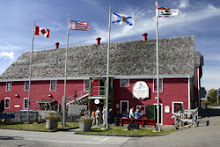
Fine dining, especially in seafood restaurants, often involves succulent scallop dishes. Whether they are wrapped in bacon and broiled, pan fried or in a chowder, scallops can be prepared and enjoyed in many ways.
The final presentation of scallops on a dinner plate, however, bears little resemblance to the bivalve in the wild. Many visitors to the Fisheries Museum of the Atlantic are astounded when they visit our aquarium and see what a scallop "really looks like".
The scallops that we eat are actually only one part of the entire scallop. Neatly enclosed within two curved shell halves, the edible meat is the adductor muscle. The muscle is well-developed, since scallops swim by using the muscle to open and close their shell. The clapping motion can sometimes result in the scallop making a sound, as it moves along the ocean bottom.
Scallops have been well-represented in ancient rites (often as fertility symbols), used by Christian pilgrims as a sign of devotion to a particular Saint and have been heraldic symbols. The family crest of Sir Winston Churchill includes scallops.
They also appear in many well-known paintings, including Botticelli’s "The Birth of Venus".
Whether your interest in scallops is culinary, historical or of an aquatic nature, you can enjoy your fill at the Fisheries Museum of the Atlantic.
The Nova Scotia Museum has an excellent page about scallops at http://www.seasidelive.ca/oceansliveEnglish/ Click on "3D Creatures" and it will take you to the section that includes an interactive unit about scallops.
Wishing you Smooth Sailing,
Heather

No comments:
Post a Comment